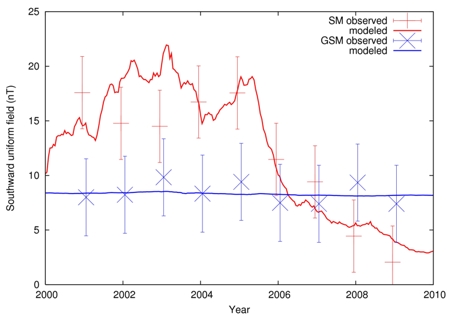| |
Geomagnetism |
|
| Home | Magnetic Field Overview | Model and software downloads | Online Calculators | Magnetic Data Sources | Geomagnetic Tutorials |
|---|
|
POMME is a main field model providing the geomagnetic field in the region from the Earth's surface to an altitude of a couple of thousand kilometers. The time variations of the field are represented by a Taylor series of the spherical harmonic (Gauss) coefficients of the magnetic potential. We provide the static coefficients for 2005.0 and the first and second time derivatives (secular variation and secular acceleration). As in POMME-5, we have split the secular acceleration into pre-2005 and post-2005 values. This is equivalent to a Taylor series expansion at 2005.0 using a different 2nd time derivative before and after 2005. Pomme-6 is based on CHAMP satellite magnetic measurements from July 2000 up to the end of August 2009. POMME-6 employs an improved parametrization of the magnetospheric magnetic field. Recent satellite observations show that the quiet-time magnetospheric ring current exhibits a significant solar-cycle dependence, with a time lag of about 20 months. Its strength reaches about 20 nT after solar maximum and more or less diminishes at solar minimum. This variation is described in the solar-magnetic (SM) frame in POMME-6 using the 81-day average of the solar flux index F10.7. A further component, newly introduced in POMME-6, is the dependence of the currents in the magnetotail on the merging electric field (Em) at the magnetopause. This field contribution is described in the geocentric solar-magnetospheric (GSM) frame. The model is more accurate if the present state of the magnetosphere is provided as an input in the form of magnetic indices. Unfortunately, these indices are presently not easily available in real-time, so any real-time evaluation of the model has to use default values. The magnetospheric ring current is tracked by Est/Ist (the default values for Est and Ist are both 0.0). The Interplanetary magnetic field is available in SPIDR or from OMNIWEB (default IMF-BY = 0.0). The merging electric field Em is a parameter derived from the solar wind measurements by: Em (in mV/m) = V * BT * sin(beta/2.0) * sin(beta/2.0) / 1000 where V is the solar wind flow speed in km/s, BT is the strength of the interplanetary magnetic field perpendicular to the Sun-Earth axis and beta is the clock angle acos(Bz/BT). Use the default value of 0.5 mV/m if the value of Em is not known. The F10.7 solar flux is available in SPIDR . The model requires the 81-day average value 20 months prior. (default value is 120.0). |

Fig.1: (click to enlarge) CHAMP satellite-observed strengths of southward uniform fields in SM (red crosses) and GSM (blue crosses) with corresponding POMME-6 predictions. The error bars were inferred from the difference between CHAMP and Oersted satellite observations. Fig.2: (click to enlarge) Breakup of the total SM component in the POMME-6 model (black) into three contributions: DC component, Est modulated component (actually -0.87 * Est), and F10.7 modulated component, taking the 81 day running average of F10.7 centered on 20 months earlier. |
|||||||||||||||||||||||||||||||||||||||||||
|
||||||||||||||||||||||||||||||||||||||||||||
| Stefan Maus | ||||||||||||||||||||||||||||||||||||||||||||
|
Last modified: Friday, 20-Aug-2010 08:45:19 MDT |
||||||||||||||||||||||||||||||||||||||||||||